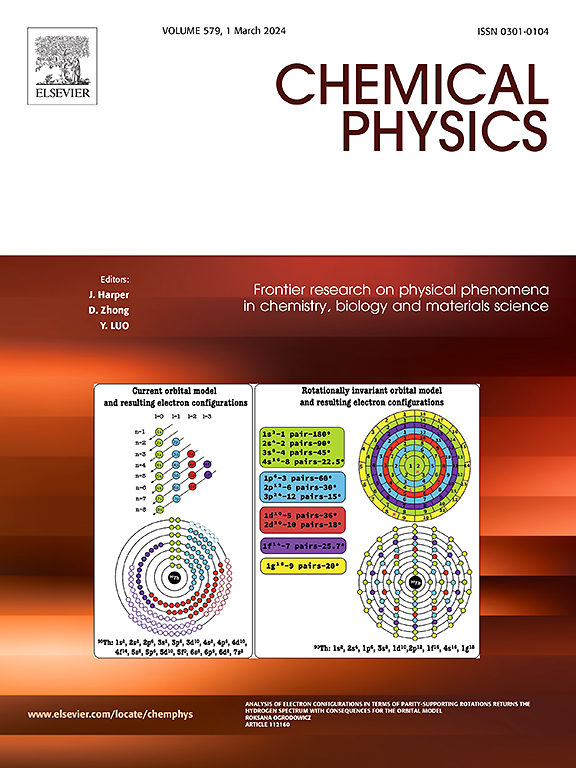阳离子染料中端基对温度依赖性激发态弛豫的影响
IF 2
3区 化学
Q4 CHEMISTRY, PHYSICAL
引用次数: 0
摘要
阳离子有机染料带有沿分子分布的正电荷,这种电荷的局域性显著影响其对称性和光学性质。根据不同的因素(末端基团的拓扑结构、溶剂的极性和温度),这些染料中的多烯、多甲基或供体-受体结构形式,以及这些系统的激发态弛豫还没有得到充分的研究,特别是在低温下。在室温下,所研究的阳离子染料不考虑基态时的对称性,而在激发态时大多是对称的。在低温下,电荷局域化效应变得明显,导致基态和激发态的对称性破缺。本文通过分析实验低温时间分辨光谱并结合量子化学计算,研究了阳离子染料末端基团对激发态弛豫的影响。在聚甲基波段(700-730 nm)的反斯托克斯范围内的独特发射(690 nm)特征是多烯结构的形成取决于温度、溶剂极性和染料末端基团的供电荷性质。此外,在低温时间分辨光致发光中,可以区分出760 nm波段,并与分子内电荷转移有关。计算结果表明,不同分子片段(聚甲基链和端基)的总正电荷分布不均匀,聚甲基链上形成了负电荷。我们提出了一个线性阳离子分子系统的激发态弛豫跃迁模型,使供体-受体特征成为可能。该模型为设计具有可调特性的新功能材料或用于人工光合作用的有效能量传递系统提供了有价值的见解。本文章由计算机程序翻译,如有差异,请以英文原文为准。

Impact of terminal group on temperature-dependent excited state relaxation in cationic dyes
Cationic organic dyes carry a positive charge distributed along the molecule, and the localization of this charge significantly affects their symmetry and optical properties. Depending on the different factors (topology of the terminal groups, the polarity of the solvent, and the temperature) the polyene, polymethine, or donor-acceptor structure form in such dyes, and excited state relaxation for such systems is not fully explored, particularly at low temperatures. At room temperature, the studied cationic dyes, regardless of symmetry in the ground state, are mostly symmetrical in the excited state. At low temperatures, charge localization effects become evident, leading to symmetry breaking in both ground and excited states. In this paper, we distinguish how terminal groups at the end of the cationic dyes impact the relaxation of excited states by analyzing experimental low-temperature time-resolved spectra combined with quantum-chemical calculations. Distinctive emission (690 nm) in the anti-Stokes range of polymethine band (700–730 nm) features polyene structures forming depending on the temperature, solvent polarity, and charge-donating properties of the dye's terminal groups. Furthermore, in low-temperature time-resolved photoluminescence, a 760 nm band is distinguished and associated with intramolecular charge transfer. Our calculations revealed unequal distribution of total positive charge in different molecular fragments (polymethine chain and terminal groups) and formation of negative charge on polymethine chain. We propose a model of excited state relaxation transitions for linear cationic molecular systems that enable donor-acceptor features. This model offers valuable insights for designing new functional materials with tunable properties or efficient energy transfer systems for artificial photosynthesis.
求助全文
通过发布文献求助,成功后即可免费获取论文全文。
去求助
来源期刊

Chemical Physics
化学-物理:原子、分子和化学物理
CiteScore
4.60
自引率
4.30%
发文量
278
审稿时长
39 days
期刊介绍:
Chemical Physics publishes experimental and theoretical papers on all aspects of chemical physics. In this journal, experiments are related to theory, and in turn theoretical papers are related to present or future experiments. Subjects covered include: spectroscopy and molecular structure, interacting systems, relaxation phenomena, biological systems, materials, fundamental problems in molecular reactivity, molecular quantum theory and statistical mechanics. Computational chemistry studies of routine character are not appropriate for this journal.
 求助内容:
求助内容: 应助结果提醒方式:
应助结果提醒方式:


